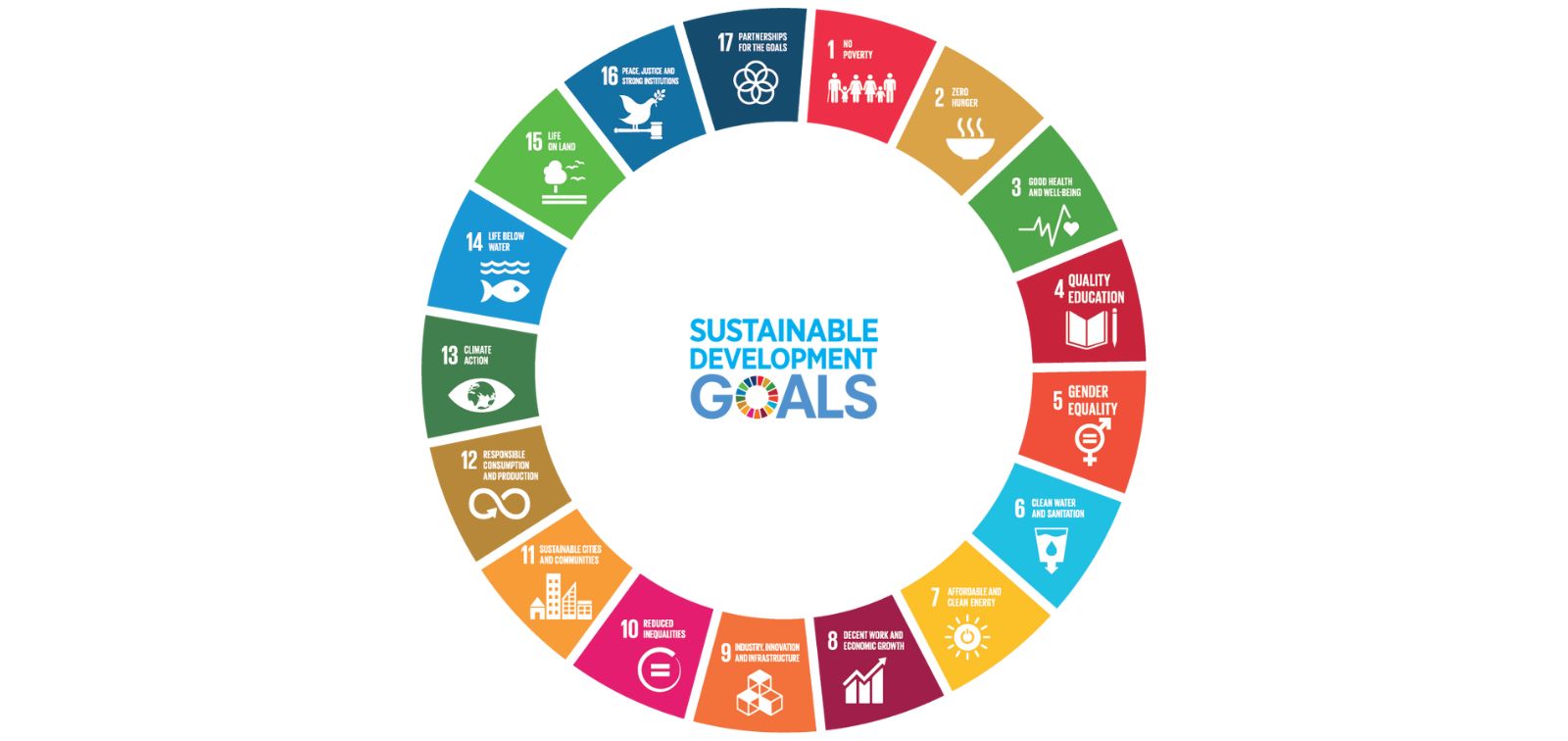Sustainable Development Goals and Global Health
We seek to strengthen the role of knowledge and innovation in the implementation of the SDGs

What are the SDGs and why do they matter for health?
The Sustainable Development Goals (SDGs) are a set of 17 global goals adopted by the member states of the United Nations in 2015 as part of the 2030 Agenda. These goals aim to eradicate poverty, protect the planet, and ensure prosperity for all people, with specific targets to be achieved by 2030. The SDGs cover areas such as education, gender equality, climate change, peace, justice, decent work, and, of course, health.
Unlike the Millennium Development Goals (MDGs), which were mostly focused on developing countries, the SDGs have a universal approach and require the commitment of all countries, regardless of their level of development. The 2030 Agenda establishes a transformative framework that promotes sustainable development in its three dimensions: economic, social, and environmental. This agenda seeks to “leave no one behind”, prioritizing equity and social inclusion as fundamental pillars.
In this context, the 2030 Agenda recognizes that human development cannot be achieved without ensuring healthy living conditions for everyone. This is why access to health and well-being is placed as a central priority, not only as a specific goal (SDG 3), but also as an essential component for achieving the rest of the goals. Many factors that determine people's health status —known as social determinants of health— are related to the conditions in which people are born, grow, live, work, and age.
Furthermore, improving population health helps reduce poverty, increase economic productivity, and strengthen social cohesion. Recognizing its cross-cutting role implies adopting intersectoral and collaborative approaches, where health policies are integrated with other areas such as housing, education, transport, and the environment.
SDGs related to health: beyond SDG 3
SDG 3, "Ensure healthy lives and promote well-being for all at all ages", represents the goal most explicitly linked to health. This goal includes targets such as reducing maternal and child mortality, fighting communicable and non-communicable diseases, ensuring access to essential health services, achieving universal health coverage, and promoting mental health.
However, health is deeply intertwined with other SDGs that, even if they do not explicitly mention health, have a decisive impact on its social determinants. SDG 1 aims to end poverty in all its forms, a factor closely tied to health. People living in poverty often face more barriers to accessing health services, adequate nutrition, decent housing, and safe working conditions. Similarly, SDG 2 focuses on ending hunger and improving nutrition, which is key to preventing diseases related to childhood malnutrition, anemia, obesity, and chronic illnesses. Healthy nutrition is essential for physical and intellectual development from childhood to adulthood.
SDG 4, by promoting quality education, contributes to a better understanding of healthy habits, appropriate use of health services, and self-care. SDG 5, focused on gender equality, also has a direct influence on health, especially regarding sexual and reproductive health, protection against gender-based violence, and equitable access to healthcare services. SDG 6 seeks to ensure universal access to safe water and sanitation, which is essential to prevent infectious diseases such as cholera or diarrhea, which disproportionately affect vulnerable populations.
On the other hand, SDG 10 addresses reducing inequalities, which has direct implications for health equity. Socioeconomic, geographic, or ethnic differences condition access to services and healthy opportunities. SDG 11, on sustainable cities, highlights the importance of urban planning that promotes healthy, safe, and accessible environments, including active transport, green spaces, and clean air. Finally, SDG 13 recognizes the threat of climate change to global health, from increasing respiratory diseases to the impact of extreme events such as heatwaves, floods, or food insecurity, which exacerbate existing vulnerabilities.
SDG 3: Health and Well-being – Key targets
Maternal and child mortality
One of the priority targets of SDG 3 is to reduce the global maternal mortality ratio to less than 70 per 100,000 live births. However, in 2020, the global rate was 223 maternal deaths, with regions such as Sub-Saharan Africa registering figures up to seven times higher than the world average. Most of these deaths are preventable through prenatal care, safe deliveries, and basic sexual and reproductive health services.
Regarding childhood, the aim is to end preventable deaths of newborns and children under five years of age. In 2022, 4.9 million children under 5 died, most within the first months of life. The target is to reduce this figure to less than 25 deaths per 1,000 live births (children under 5 years old) and less than 12 per 1,000 (newborns). Timely healthcare, adequate nutrition, and maternal education are key factors to achieve this target.
Communicable and non-communicable diseases
SDG 3 seeks to end the epidemics of HIV/AIDS, tuberculosis, malaria, and neglected tropical diseases. Although significant progress has been made, in 2022 there were still 630,000 deaths from HIV, 1.3 million from tuberculosis, and 608,000 from malaria. These diseases mostly affect contexts with fragile health systems, poverty, and lack of access to treatments.
At the same time, non-communicable diseases (NCDs) —such as cancer, diabetes, or cardiovascular diseases— represent a growing challenge. They are responsible for about 74% of all deaths worldwide, around 41 million deaths annually. The target is to reduce premature mortality from NCDs by one-third through health promotion, early detection, and access to treatment.
Universal health coverage and access to medicines
Mental health has become an increasing priority within SDG 3, with the goal of reducing suicide rates and improving the treatment of mental, neurological, and substance use disorders. Every year, more than 700,000 people die by suicide, and millions live with untreated disorders due to stigma and lack of adequate services, especially in low- and middle-income countries.
On the other hand, road safety and accident prevention are key components of well-being. Traffic accidents cause more than 1.19 million deaths annually and are the leading cause of death among people aged 5 to 29. SDG 3 seeks to reduce these figures through prevention policies, safe infrastructure, and effective regulation of traffic and substance use.
Public policies and health research
Achieving SDG 3 requires strong public policies, sustained investment, and an intersectoral perspective. Many countries still allocate less than 5% of their GDP to health, which limits the capacity to provide equitable and quality care. Strengthening governance, social participation, health information systems, and territorial equity is also crucial.
Scientific research and health innovation are essential drivers of progress. The COVID-19 pandemic showed how investment in science can save millions of lives but also highlighted inequalities in access to knowledge and technologies. Investing in research —especially in neglected diseases and health systems— is crucial to anticipate future threats and improve global health equitably.
What WHO says about SDGs and health
The World Health Organization (WHO) recognizes the 2030 Agenda and the Sustainable Development Goals (SDGs) as an essential framework to guide global action on health. Since their adoption in 2015, WHO has reaffirmed that SDG 3: Health and Well-being is not only a specific goal but also a cross-cutting component that conditions and reflects progress in other SDGs. Health, according to WHO, is a human right and an indispensable condition for sustainable development.
In its institutional stance, WHO promotes a comprehensive vision of health, advocating for resilient health systems, quality primary care, intersectoral approaches, and evidence-informed public policies. It also stresses the need to reduce health inequalities and address the social, economic, and environmental determinants of health. For WHO, achieving the SDGs requires collaborative global governance, based on solidarity and the principle of “leaving no one behind”.
WHO has published numerous global and regional reports to monitor progress on SDG 3 and its relationship with other goals. One of the main tools is the Global Monitoring Report on Universal Health Coverage, which measures effective access to essential health services and financial protection. The annual World Health Statistics also provide comparable data on health indicators across all member countries.
Additionally, WHO coordinates and contributes to reports such as the SDG3 Global Action Plan Progress Report, developed jointly with other UN agencies, which evaluates collective progress in implementing health targets. These reports identify gaps, propose recommendations, and highlight best practices that can be replicated. In all cases, WHO underlines the urgency of increasing investment in public health and accelerating the implementation of SDGs.
WHO coordination with governments and NGOs
WHO plays an active role in international coordination for the implementation of SDG 3, working directly with governments, multilateral agencies, non-governmental organizations (NGOs), and civil society. It provides technical assistance, develops guidelines and standards, and supports countries in planning, executing, and monitoring health policies aligned with the SDGs.
A notable example of this coordination is the Global Action Plan for Healthy Lives and Well-being for All, which brings together 13 international agencies to work jointly and more efficiently in supporting countries. These agencies are:
- World Health Organization (WHO)
- UNICEF
- UNFPA
- UNAIDS
- Gavi, the Vaccine Alliance
- PMNCH (Partnership for Maternal, Newborn & Child Health)
- The Global Fund
- RMNCH Trust Fund
- International Labour Organization (ILO)
- World Bank
- Organisation for Economic Co-operation and Development (OECD)
- UN Women
- United Nations Industrial Development Organization (UNIDO)
These organizations work under the principle of "more impact through better collaboration", aligning strategies and resources to support countries in their roadmaps towards achieving SDG 3, with a focus on human rights, equity, and sustainability.
ISGlobal's contribution to the SDGs
ISGlobal Strategy 2020-2030
ISGlobal is one of the leading global centers in research and policy on global health. Combining research on communicable diseases with the study of chronic diseases and their environmental and climate-related causes, it has progressively embraced the principles of the 2030 Agenda, strengthening the role of knowledge, innovation, and capacity building for the implementation of the Sustainable Development Goals (SDGs).
In June 2020, a participatory internal process began to define ISGlobal's direction and priorities in relation to the 2030 Agenda, through the development of the corporate strategy on SDGs 2020-2030, which was presented in November 2021. The aim is to become a sustainable institution, enhance our impact on policymaking related to global health, and demonstrate our commitment to the SDGs transparently and accountably.
The SDG Strategy 2020-2030 reflects the institution's direct link with SDGs 3 (health), 11 (cities), and 17 (partnerships), followed by SDGs 4 (education), 5 (gender), 8 (decent work), 10 (inequality), 12 (responsible consumption and production), and 13 (climate change). The document also presents 17 strategic objectives that the institution considers priorities for ISGlobal's effective contribution to the 2030 Agenda and sets a series of performance indicators to monitor the implementation of planned actions in five work areas: sustainability, equity, research and innovation, policy advocacy, and health impact.
Global initiatives and partnerships
ISGlobal is part of the UN Global Compact Spain and actively participates in networks and collaboration spaces to advance SDG implementation. At the local and regional levels, it is part of the Barcelona + Sustainable Network, the 2030 Agenda Academic Advisory Council of the Barcelona City Council, the Catalonia 2030 Alliance promoted by the Generalitat, and the Observatory SDG Advisory Council led by the “la Caixa” Foundation and Esade. Internationally, it coordinates the Health for All initiative together with academic institutions from China and India, within the Sustainable Development Solutions Network (SDSN), under the leadership of Jeffrey Sachs. It is also a member of the Advisory Council of the Spanish Network for Sustainable Development (REDS).
Ongoing projects and case studies
ISGlobal drives research programs focused on SDG 3 and other SDGs with a direct or indirect impact on health, translating knowledge into practical solutions. Among them, the program on Maternal, Child and Reproductive Health stands out, focusing on improving malaria control in pregnant women and children, identifying causes of maternal and child mortality, and evaluating maternal immunization. Meanwhile, the program on Climate, Air Pollution, Nature, and Urban Health studies the effects of climate change and urban exposures (such as pollution, temperature, green spaces, and noise) on health, as well as the health benefits of climate policies.
Other action lines related to promoting the SDGs are led by the Translation and Impact area. For example, through strengthening health as a strategic intervention area for Spanish cooperation, offering new ideas to improve its impact,





